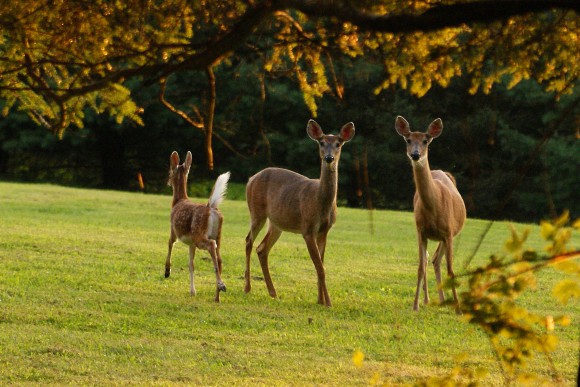 Spring is when many New Jersey residents purchase and plant trees, bushes and garden plants only to find them consumed by deer. This article was written by Brooke Maslo, assistant extension specialist in wildlife ecology and assistant professor in the Department of Ecology, Evolution and Natural Resources and originally appeared in Gardener News.
Spring is when many New Jersey residents purchase and plant trees, bushes and garden plants only to find them consumed by deer. This article was written by Brooke Maslo, assistant extension specialist in wildlife ecology and assistant professor in the Department of Ecology, Evolution and Natural Resources and originally appeared in Gardener News.
White-tailed deer are arguably one of the best examples of the successful conservation of a North American wildlife species. By the late 1880s, deer in the northeastern US were hunted to near extirpation. In fact, the New Jersey population was so low that deer were brought in from other states to help supplement existing herds. Restocking efforts, coupled with the enactment of protective regulations and the eradication of natural predators (wolves and cougars), allowed the deer population to quickly rebound. Now, deer are considered an overabundant species in this region, and they are both loved and loathed for their many interactions with people.
As majestic as it is to watch the graceful prancing of a deer herd through one’s yard, there is no contesting the significant damage deer are capable of causing to home gardens and landscapes. Residential plantings offer a constant supply of high-quality food resources for deer in a safe environment where hunting is prohibited. While economic losses vary greatly by locations, studies estimate an average cost of $200-800 in landscape damage per single-family household. Aside from the money, there is nothing more frustrating than watching the fruits (and vegetables, too) of your hard labor literally vanish overnight.
There are certainly tools to assist in the battle for the burbs. Taste- or odor-based repellents can be effective at discouraging deer in small gardens or beds. Only certain commercial products are approved for use on garden vegetables or fruit trees, and some chemicals have a time window in which food should not be harvested. Make certain to read the labels carefully and wash food well. More natural repellents include urine from a natural predator; hot sauce derived from capsaicin in pepper; and putrescent eggs. Attractiveness and palatability of the plants, deer hunger, amount of rainfall, and local food preference are among factors influencing repellent effectiveness. To maximize success, repellents should be used with additional deer management tactics in an integrated approach.
Exclusion methods can be effective as well. Individual plants can be protected with flexible netting or wire caging, and tree seedlings can be covered with plastic tubes (tree shelters). Although labor-intensive, protecting individual plants has been shown to be successful in many situations. However, use of tree shelters may inadvertently increase mortality of songbirds, such as bluebirds, which enter the tube chasing an insect and ultimately get caught inside. Flexible netting or some other device to block entrance to the tubes should be employed. Fencing larger areas is helpful, provided the fence is at least 6 feet in height. With enough clearance, deer can easily hurdle even an 8-foot fence.
Homeowners also have the option to plant a variety of alternative landscape plants that are unpalatable to deer. Unfortunately, many of these plants, such as Japanese barberry (Berberis thunbergii) and burning bush (Euonymus alatus), disperse into natural areas and cause incredible negative impacts. Luckily, deer resistant native plants are now available at several native plant nurseries and even at some of the larger garden centers. For an extensive list of deer resistant native plants, visit the Bowman’s Hill Wildflower Preserve website and click on the Gardening with Natives link. Keep in mind that deer resistant does not equal deer proof.
Despite these individual measures, reductions of negative deer-human interactions (landscape damage, vehicle collisions, tick-borne diseases, ecological impacts) over the long term involve restoring deer populations to manageable levels. Sport hunting is considered the most cost-effective, efficient method of deer management. Hunters have been successful in reducing deer densities where they have access to hunting lands; however, the lack of hunter access continues to be a severe obstacle to successful deer management here in the most densely populated state in the nation. In deer management zones with more restrictive hunting regulations, communities may apply for a Deer Management Assistance Permit (DMAP), which allows for the take of additional antlerless deer in order to meet management goals. In areas where sport hunting is not practical, the New Jersey Division of Fish and Wildlife can issue a Community Based Deer Management Permit (CBDMP), which allows for lethal methods not permitted under sport hunting regulations. The CBDMP program allows sharp-shooting by specially trained professionals and, in some cases, euthanasia of individual deer. Overall, deer management in New Jersey requires an integrated strategy involving lethal and non-lethal measures on both the local and statewide scale.
The bulletin “Landscape Plants Rated by Deer Resistance” (E271) is available along with other NJAES publications on our website.

